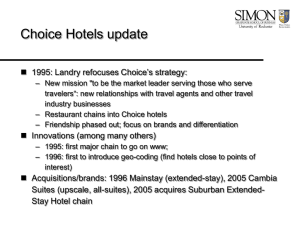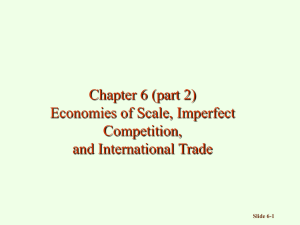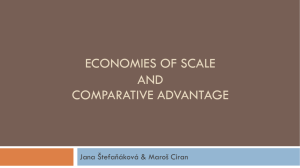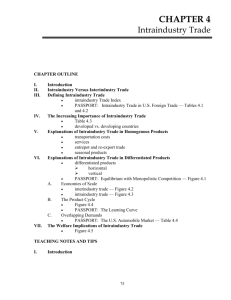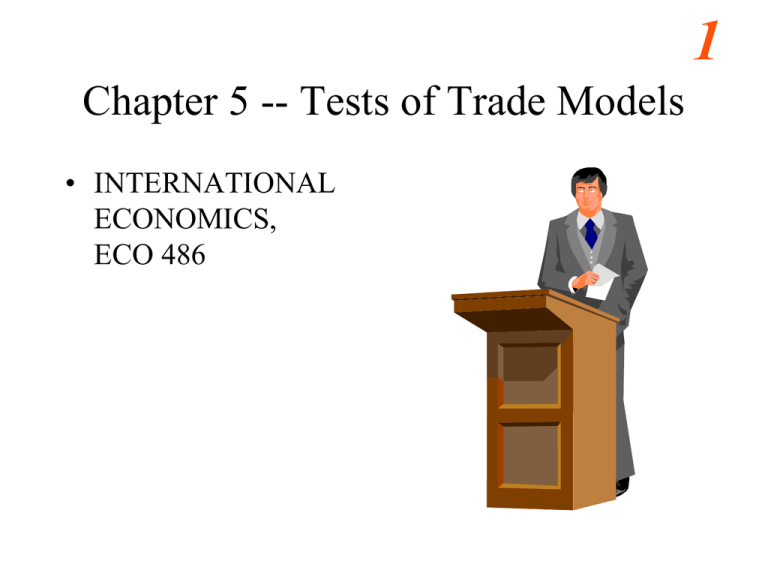
1
Chapter 5 -- Tests of Trade Models
• INTERNATIONAL
ECONOMICS,
ECO 486
2
Learning Objectives
• Understand the results of well-known tests
of the Classical and HO Models.
• Become familiar with new theories
concerning the source of comparative
advantage
• Understand intra-industry trade, and
calculate IIT.
4
Tests of the Classical Model
• MacDougall compared US and British
exports for 1937.
– Calculated APL
– Compared relative APL to relative wage
• America’s wages were twice those in Britain
• Classical model predicts that US would
export a good if its labor is more than twice
as productive.
5
Table 5.1, MacDougall’s Test
Industry
Radios
APLUS EXUS
APLUK EXUK
>2
8
Cigarettes
1.4-2
0.5
Beer
1.4-2
0.06
Men's woolens < 1.4
0.04
Margarine
0.03
< 1.4
p. 123
6
7
Tests of the Classical Model
• Of 25 products tested, 20 fit this theory
• Supports a relationship between labor
productivity and exports
• Does not rule out the HO Model
• Did not control for differences in other
factors (e.g., transportation costs, resource
intensity,…)
8
Leontief’s Test of the HO Model
• Leontief, Wassily
– {lay-ohn’-tyef, vah-sil’ee}
– born 5 Aug 1906 St. Petersburg, Russia
• Leontief developed input-output (I-O) model
• Assumed that US was most K-abundant country in
1947
• HO Model predicts US exports K-intensive
• Used I-O Model to Test HO Theory
9
Leotief’s Test of the HO Model
• Test:
– Cut US exports by $1 million
– Raise US production of import-competing
goods by $1 million
10
Leontief’s Test (continued)
• Reducing production of exports released
more labor than required to expand the
production of import-competing goods.
• US imports were more capital intensive
than US exports!
• This surprising result is known as the
Leontief Paradox
12
Attempts to Resolve the Paradox
• Technology differs -- Leontief assumed that
US technology was used to produce US
imports
– High W/R firms use K-intensive methods
• Tastes differ -- Table 5.2 shows that
consumption patterns differ.
– But enough to reverse direction of CA???
13
Table 5.2, Consumption Patterns
Category
High
Low
Mean
Food
India (59.7%)
US (14.4%)
33.3%
Beverages
Ireland (14.4%)
Libya (1.1%)
5.1%
Clothing & Shoes Ghana (14.2%)
Jamaica (4.3%)
8.8%
Medical Care
UK (1.0%)
4.9%
Netherlands &
France (11.2%)
p. 129
14
Copyright © 2007 Pearson Addison-Wesley. All rights
5-14reserved.
15
Other Tests of the HO Model
• Leontief examined ‘51 data, found paradox
• Baldwin examined ‘62 data, found paradox
• Stern & Maskus examined ‘72 data,
paradox gone (assuming US was still K
abundant)
16
Test Results: Domestic Capital Required
per Labor Year per Million Dollars of …
Year
Exports
Import-Competing Goods
1947 $14,010
$18,180
Ratio of
Imports to
Exports
1.30
1951 $12,977
$13,726
1.06
1962 $14,200
$18,000
1.27
1972 $14,989
$14,218
0.95
Caves, World Trade and Payments, p. 301
18
Recent Tests of the HO Model
• Leontief linked factor intensities and trade
patterns
• Leamer linked factor endowments and trade
patterns
• HO Model links all three
19
Recent Tests of the HO Model
• Maskus
– Results contradict many HO predictions
– Used US I-O table to identify factor intensities
of US exports and imports
• Bowen (et al) looked at more countries
– Mixed results
– Used US I-O table as well, but noted that other
countries may use other technologies
20
More Recent Tests of HO Model
• Since the 1980s, more tests have been
conducted because:
– Earlier studies were incomplete since these did
not link trade patterns with factor endowments
– Using a multifactor version of the HO model,
Leamer (1980) showed that trade patterns and
factor endowments were related to each other
Copyright © 2007 Pearson Addison-Wesley. All rights
5-20reserved.
21
More Recent Tests (cont.)
• Two studies attempted to test the links
between endowments and intensities to
trade patterns:
– Maskus (1985)
– Bowen, Leamer, and Sveikauskas (1987)
• Both studies found contradictory results.
• Other studies which relaxed HO
assumptions had better results.
Copyright © 2007 Pearson Addison-Wesley. All rights
5-21reserved.
22
Most Recent Tests Combine Models
• Trefler
– By allowing for differing technology, found
support for Factor Price Equalization
– Technology and tastes included in model,
resolved many of the discrepancies
• Harrigan
– Differing technology and factor endowments
explain observed specialization in production
25
Human Skills Theory
• Kravis found that the bulk of US exports are
provided by high-wage industries
– In ’56, but still true
• Keesing (’65-6) argues that differing
endowments of K & L are less important
than differing endowments skilled and
unskilled labor
26
Product Life-cycle Theory
• Vernon argues that some countries have CA
in innovation. US has CA in developing
new products, a labor-intensive activity
• As products “mature,” production becomes
automated (K-intensive) and CA may shift
27
Product Life-cycle Theory (cont.)
• Applies only to some goods
• Cannot predict when shift will occur
• Gagnon & Rose (’95)
– few shifts (‘62 v. ’88 data)
28
Similarity of Preferences
• Linder focused on demand and
hypothesized that consumers prefer variety,
which trade provides
• Countries with similar standards of living
will produce (& trade) similar goods.
29
Similarity of Preferences
• “In each country, industries produce goods
designed to please the tastes of consumers in that
country.”
• Some people prefer products that differ trade
• Factor endowments influence standard of living
• Standard of living influences tastes
• Rich countries will trade with other rich countries
30
Similarity of Preferences (SP)
• Linder rejects HO for trade in manufactured
goods
– No paradox
• SP explains intra-industry trade
• SP applies only to differentiated products
– Linder explains trade in other goods using HO
31
Conclusions
• The world is a very complicated place.
• Developing direct tests of international
trade models is difficult due to
restrictive assumptions, data, and
measurement problems.
• International economics is an evolutionary
science.
Copyright © 2007 Pearson Addison-Wesley. All rights
5-31reserved.
32
If a Country Has Comparative Advantage in a
Good, Why Would the Country Import It?
• Transportation costs
• Data aggregation and categorization problems
• Increasing returns to scale and
imperfect competition
Copyright © 2007 Pearson Addison-Wesley. All rights
5-32reserved.
34
Intra-industry Trade (IIT)
• Occurs when countries both export and
import the products of an industry
• Not predicted by Classical or HO Models
• Some IIT is consistent with the HO Model
– Transportation costs
– Data aggregation
• Linder’s hypothesis predicts IIT
35
Intra-industry Trade (IIT)
• Grubel-Lloyd index (see p. 137 in Husted)
• Let ej = exports of j, ij = imports of j
e
i
IIT 100 50
e i
n
j 1
j
j
n
j 1
n
j
j 1
j
36
Calculate IIT, example 1
j
Industry
1 Beverages
ej
ij
$50
$0
2 Crude materials $50
$0
3 Mineral fuels
$0 $50
4 Fats & oils
$0 $50
Total
100 100
38
Calculate IIT, example 2
j
Industry
1 Beverages
ej
ij
$10 $10
2 Crude materials $10 $10
3 Mineral fuels
$10 $10
4 Fats & oils
$10 $10
Total
$40 $40
40
Table 5.3 Intra-industry Trade, 1983
Rank Country
IIT
1
United Kingdom
68.5
2
Belgium - Luxembourg 67.2
53
Gabon
5.4
54
Algeria
2.0
See page 137, Husted & Melvin, 7th edition
41
Copyright © 2007 Pearson Addison-Wesley. All rights
5-41reserved.
The Long-run
Average Cost Curve
42
• The long run average total cost curve is
derived from the short-run average total
cost curves.
• The segment of the short-run average total
cost curves along which average total cost is
the lowest make up the long-run average
total cost curve.
43
Long-run Average Cost Curve
44
Short-run and Long-run Cost
Curves
• If plant size can be varied by tiny amounts,
LRAC curve is a smooth, U-shaped curve
• The SRAC curve for each plant just touches
the LRAC curve at a single output level
45
Short-run and Long-run Cost
Curves
• SRAC touches
LRAC
• LRAC shows
economies and
diseconomies of
scale
46
Returns to Scale -- Internal to the Firm
• Describes changes in average cost as a firm
expands (literally, when a one-plant firm
builds a bigger plant)
Holding factor prices constant
• A multi-plant firm may realize some
economies as it adds additional plants
• A multi-product firm may realize some
economies of scope as it adds products
49
Slope of Long-run Industry Supply
• Increasing Cost Industry – positive slope
• Constant Cost Industry – zero slope
• Decreasing Cost Industry – negative slope
Describes how factor prices change as
an industry expands
50
Long-run Changes in
Price and Quantity
Decreasing-cost industry
Price
Increasing-cost industry
Price
Price
Constant-cost industry
S0
S0
S0
Ps
Ps
Ps
P0
P0
P0
D1
D1
D0
Q0
Qs
Quantity
D1
D0
Q0
Qs
Quantity
D0
Q0
Qs
Quantity
59
Long-run Changes in
Price and Quantity
Decreasing-cost industry
Price
Increasing-cost industry
Price
Price
Constant-cost industry
S0
S1
Ps
LSA
P0
S2
LSB
S0
Ps
P2
P0
D1
Q0
Qs
D0
Q1
Quantity
S0
Ps
S3
P0
P3
LSC
D1
Q0
D0
Qs Q2
Quantity
D1
Q0
Qs
D0
Q3
Quantity
60
Decreasing Cost Industry
• The entry of new firms causes falling input
prices. Falling input prices shift the cost
curves downward, and the short-run
industry supply curve shifts to the right.
• Long-run Industry Supply has a negative
slope.
• This describes a Decreasing Cost Industry,
61
Economies of Agglomeration
• Plants in a single industry cluster
• Three types
– A Marshallian cluster
– A North Italian cluster
– A Chandlerian firm
63
Advancing Technology
• Technological change
– New technology allows firms to produce at lower costs
• This causes their cost curves to shift downward
– Firms adopting the new technology make an economic
profit
• More new technology firms enter
– Old technology firms disappear, the price falls, and the
quantity produced increases
64
Learning by Doing
• People learn through on-the-job experience
– Learning curve analysis explores this
phenomenon
• Plot labor/unit against cumulative units produced
• Has been observed to fall by some regular
percentage for each doubling of cumulative output
• Examples from WWII – hours per destroyer fell by
52.3% from 1943-45 with no increase in K or L.
Ladder of Comparative Advantage 65
Industrial
Countries
Knowledge
intensive
Computers
Newly
Industrializing
Countries
K-intensive
Machinery
Skilled Lintensive
Electronics
Unskilled Lintensive
Textiles
HO Model
Resource
intensive
Commodities
Ricardian
Developing
Countries
Created
Comp.
Adv.
Innate
Comp.
Adv.
IRS in both S & T (p. 140)
With one-half of the resources in
each industry, less than one-half of
the potential output is produced.
F
TEXTILES, T (yards per year)
68
F/2
G
0
H
E/2
E
SOYBEANS, S (bushels per year)
71
Increasing Returns and CA
• Direction of CA is indeterminate and
contingent
– Historical accident determines the direction
• Example: If B’s textile industry expands before A’s,
then B gains CA in T. B will specialize in T
• With imperfect information, and differing
endowments, they could specialize in the wrong
goods
77
Conclusions
• Tests are inconclusive
– Results (paradox) may due to data problems
– Or, assumptions of the (2x2x2) HO Model may
be too unrealistic
• Direct tests of the HO Model are difficult
• Economic theory is still evolving
• Trefler found differing technology, factor
endowments & preferences explain trade
The Theory of External Economies
78
• Economies of scale that occur at the level of
the industry instead of the firm are called
external economies.
• There are three main reasons why a cluster of
firms may be more efficient than an individual
firm in isolation:
– Specialized suppliers
– Labor market pooling
– Knowledge spillovers
The Theory of External Economies
79
• Specialized Suppliers
– In many industries, the production of goods and
services and the development of new products
requires the use of specialized equipment or
support services.
– An individual company does not provide a large
enough market for these services to keep the
suppliers in business.
• A localized industrial cluster can solve this problem by
bringing together many firms that provide a large
enough market to support specialized suppliers.
– This phenomenon has been extensively documented in the
semiconductor industry located in Silicon Valley.
The Theory of External Economies
• Labor Market Pooling
– A cluster of firms can create a pooled market
for workers with highly specialized skills.
– It is an advantage for:
• Producers
– They are less likely to suffer from labor shortages.
• Workers
– They are less likely to become unemployed.
80
The Theory of External Economies
81
• Knowledge Spillovers
– Knowledge is one of the important input factors in
highly innovative industries.
– The specialized knowledge that is crucial to
success in innovative industries comes from:
• Research and development efforts
• Reverse engineering
• Informal exchange of information and ideas
The Theory of External Economies
82
• External Economies and Increasing Returns
– External economies can give rise to increasing
returns to scale at the level of the national
industry.
– Forward-falling supply curve
• The larger the industry’s output, the lower the price
at which firms are willing to sell their output.
External Economies and Trade
83
• External Economies and the Pattern of Trade
– A country that has large production in some industry will
tend to have low costs of producing that good.
– Countries that start out as large producers in certain
industries tend to remain large producers even if some
other country could potentially produce the goods more
cheaply.
• Next figure illustrates a case where a pattern of specialization
established by historical accident is persistent.
External Economies and Trade
84
External Economies and Specialization
Price, AC
($/watch)
The Swiss industry has
lower AC because the
industry is large, even
though the individual
firms are small.
AC0
P1
1
ACSWISS
2
ACTHAI
D
Q1 Quantity of watches
produced and demanded
External Economies and Trade
85
• Trade and Welfare with External Economies
– Trade based on external economies has more
ambiguous effects on national welfare than either trade
based on comparative advantage or trade based on
economies of scale at the level of the firm.
• An example of how a country can actually be worse off with
trade than without is shown next.
External Economies and Trade
86
External Economies and Losses from Trade
Price, AC
($/watch)
If the Thai industry can
be encouraged, it might
have a lower AC.
AC0
1
P1
P2
ACSWISS
2
ACTHAI
DTHAI
DWORLD
Quantity of watches
produced and demanded
External Economies and Trade
87
• Dynamic Increasing Returns
– Learning curve
• It relates unit cost to cumulative output.
• It is downward sloping because of the effect of the experience
gained though production on costs.
– Dynamic increasing returns
• A case when costs fall with cumulative production over time,
rather than with the current rate of production.
– Dynamic scale economies may justify protectionism.
• Temporary protection of industries enables them to gain
experience (infant industry argument).
External Economies and
International Trade
• Dynamic Increasing Returns (continued)
– Learning-by-doing example: Liberty ships
• 1941-1944, US produced 2,500 Liberty cargo ships.
– 1941: 1.2 million person-hours to build a ship
– 1942: 0.6 million person-hours to build a ship
– 1943: 0.5 million person-hours to build a ship
• Physical capital used changed only slightly
• Much human capital was accumulated, more than
doubling productivity.
88
External Economies and Trade
89
The Learning Curve – Home’s experience gives it a cost advantage over
Foreign, even though Foreign has, say, lower wages.
AC ($/ship)
AC*0
AC1
L
L*
QL
Cumulative
output
Monopolistic Competition and
Trade
90
• The monopolistic competition model can be used to
show how trade leads to:
– A lower average price due to scale economies
– The availability of a greater variety of goods due to
product differentiation
– Imports and exports within each industry (intra-industry
trade, IIT)
Monopolistic Competition and
Trade
• The Effects of Increased Market Size
– The number of firms in a monopolistically
competitive industry and the prices they charge
are affected by the size of the market.
91
Monopolistic Competition and
Trade
92
Effects of a Larger Market
Average Cost, AC, and
Price, P
CC1: AC
= n (F/S) + c
1
P1
CC2
2
P2
PP:
c
P = c + 1 /(bn)
n1
n2 Number
of firms, n
Monopolistic Competition and
Trade
93
– If manufactures is a monopolistically competitive
sector, world trade consists of two parts:
• Intraindustry trade
– The exchange of manufactures for manufactures
• Interindustry trade
– The exchange of manufactures for food
Monopolistic Competition and
Trade
94
Trade with Increasing Returns and Monopolistic Competition
Home
(capital abundant)
Foreign
(labor abundant)
Manufactures
Food
Interindustry
trade
Intraindustry
trade
Monopolistic Competition and
Trade
95
– Main differences between interindustry and
intraindustry trade:
• Interindustry trade reflects comparative advantage,
whereas intraindustry trade does not.
• The pattern of intraindustry trade itself is unpredictable,
whereas that of interindustry trade is determined by
underlying differences between countries.
• The relative importance of intraindustry and interindustry
trade depends on how similar countries are.
Monopolistic Competition and
Trade
• The Significance of Intraindustry Trade (IIT)
– About 1/4 of world trade consists of IIT
– IIT plays a particularly large role in the trade in
manufactured goods among advanced industrial
nations, which accounts for most of world trade.
96
Monopolistic Competition and Trade
97
• Why Intraindustry Trade Matters
– Intraindustry trade allows countries to benefit from
larger markets.
• The case study of the North American Auto Pact of
1964 indicates that the gains from creating an integrated
industry in two countries can be substantial.
– Gains from intraindustry trade will be large when
economies of scale are strong and products are
highly differentiated.
• For example, sophisticated manufactured goods.
Monopolistic Competition and Trade
98
• Why Intraindustry Trade Matters (continued)
– Consumers gain more variety at a lower prices
than those that would prevail without trade.
– Production is more efficient. (Larger market
allows full exploitation of economies of scale.)
– When similar countries trade, the resulting change
in the income distribution (capital v. labor) will be
small
– Thus, everyone may gain from trade.






